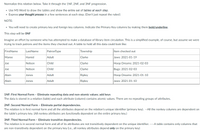
Database System Concepts
7th Edition
ISBN: 9780078022159
Author: Abraham Silberschatz Professor, Henry F. Korth, S. Sudarshan
Publisher: McGraw-Hill Education
expand_more
expand_more
format_list_bulleted
Question
can you help to solve this

Transcribed Image Text:Normalize this relation below. Take it through the 1NF, 2NF, and 3NF progression.
• Use MS Word to draw the tables and show the entire set of tables at each step.
Express your thought process in a few sentences at each step. (Don't just repeat the rules!)
NOTE:
• You will need to create primary key and foreign key columns. Indicate the Primary Key columns by making them bold/underline.
This step will be ONF
Imagine an effort by someone who has attempted to make a database of library item circulation. This is a simplified example, of course, but assume we were
trying to track patrons and the items they checked out. A table to hold all this data could look like:
FirstName
LastName
PatronType
Township
Item checked out
Maree
Hamid
Adult
Clarke
Jaws: 2021-01-19
Joe
Nelson
Child
Clarke
Hoop Dreams: 2021-02-03
Joe
Nelson
Child
Clarke
Bugs: 2021-02-03
|Alain
Jones
Adult
Ripley
Hoop Dreams: 2021-01-10
Alain
Jones
Adult
Ripley
Jaws: 2021-01-10
1NF: First Normal Form - Eliminate repeating data and non-atomic values; add keys
The data is stored in a relation (table) and each attribute (column) contains atomic values. There are no repeating groups of attributes.
2NF: Second Normal Form - Eliminate partial dependencies.
The relation is in fırst normal form and all the attributes depend on the relation's unique identifier (primary key). --All the nonkey columns are dependent on
the table's primary key. (All nonkey attributes are functionally dependent on the entire primary key.)
3NF: Third Normal Form - Eliminate transitive dependencies.
The relation is in second normal form and all of its attributes are not transitively dependent on the unique identifier. ----A table contains only columns that
are non-transitively dependent on the primary key (i.e., all nonkey attributes depend only on the primary key)
Expert Solution
This question has been solved!
Explore an expertly crafted, step-by-step solution for a thorough understanding of key concepts.
This is a popular solution
Trending nowThis is a popular solution!
Step by stepSolved in 2 steps with 6 images

Knowledge Booster
Similar questions
- What is Apache, and how does it function? What is the price of it? Is it presently capable of doing what I need it to? To get an answer to this question, you may wish to consult Wikipedia.arrow_forwardHow are the meanings in the DDL used in real life? Can you name a few methods? Please tell me what I can do to help you.arrow_forwardSo, tell me, what is it that you want to achieve with this authentication thing? Think about the benefits and drawbacks of various authentication methods, and share your thoughts.arrow_forward
- Why is it necessary to place restrictions on people's access to certain things in today's society? If you respond to this, I would appreciate it if you could provide at least two instances of access limits.arrow_forwardHow long can a user be temporarily blocked for? If so, for how long? Explain?arrow_forwardIs there anything that authentication can do for us? In this part, we'll look at the advantages and disadvantages of various types of authentication.arrow_forward
- What can we achieve with the aid of authentication? In this section, we'll look at the benefits and drawbacks of various methods of authentication.arrow_forwardIs there a chance that authentication will help us reach our goals? In this section, we'll look at the pros and cons of some popular authentication methods.arrow_forwardHow can I send you a picture of the problem?arrow_forward
- What are advantages of implementing “Principle of Authentication”.? What are disadvantages? if we do not implement “Principle of Authentication”.arrow_forwardWe tell people and tell people not to use words from the dictionary as password, but they just don't listen . . . Can you find this one word, three-letter, bad password? By the way, this challenge is not really meant for you to manually guess!arrow_forwardCould you please describe the idea of a challenge-and-response authentication system to me in your own words so that I can fully grasp it? (CRAS). What about this technique of authentication is more secure than using a password?arrow_forward
arrow_back_ios
SEE MORE QUESTIONS
arrow_forward_ios
Recommended textbooks for you
 Database System ConceptsComputer ScienceISBN:9780078022159Author:Abraham Silberschatz Professor, Henry F. Korth, S. SudarshanPublisher:McGraw-Hill Education
Database System ConceptsComputer ScienceISBN:9780078022159Author:Abraham Silberschatz Professor, Henry F. Korth, S. SudarshanPublisher:McGraw-Hill Education Starting Out with Python (4th Edition)Computer ScienceISBN:9780134444321Author:Tony GaddisPublisher:PEARSON
Starting Out with Python (4th Edition)Computer ScienceISBN:9780134444321Author:Tony GaddisPublisher:PEARSON Digital Fundamentals (11th Edition)Computer ScienceISBN:9780132737968Author:Thomas L. FloydPublisher:PEARSON
Digital Fundamentals (11th Edition)Computer ScienceISBN:9780132737968Author:Thomas L. FloydPublisher:PEARSON C How to Program (8th Edition)Computer ScienceISBN:9780133976892Author:Paul J. Deitel, Harvey DeitelPublisher:PEARSON
C How to Program (8th Edition)Computer ScienceISBN:9780133976892Author:Paul J. Deitel, Harvey DeitelPublisher:PEARSON Database Systems: Design, Implementation, & Manag...Computer ScienceISBN:9781337627900Author:Carlos Coronel, Steven MorrisPublisher:Cengage Learning
Database Systems: Design, Implementation, & Manag...Computer ScienceISBN:9781337627900Author:Carlos Coronel, Steven MorrisPublisher:Cengage Learning Programmable Logic ControllersComputer ScienceISBN:9780073373843Author:Frank D. PetruzellaPublisher:McGraw-Hill Education
Programmable Logic ControllersComputer ScienceISBN:9780073373843Author:Frank D. PetruzellaPublisher:McGraw-Hill Education

Database System Concepts
Computer Science
ISBN:9780078022159
Author:Abraham Silberschatz Professor, Henry F. Korth, S. Sudarshan
Publisher:McGraw-Hill Education

Starting Out with Python (4th Edition)
Computer Science
ISBN:9780134444321
Author:Tony Gaddis
Publisher:PEARSON

Digital Fundamentals (11th Edition)
Computer Science
ISBN:9780132737968
Author:Thomas L. Floyd
Publisher:PEARSON

C How to Program (8th Edition)
Computer Science
ISBN:9780133976892
Author:Paul J. Deitel, Harvey Deitel
Publisher:PEARSON

Database Systems: Design, Implementation, & Manag...
Computer Science
ISBN:9781337627900
Author:Carlos Coronel, Steven Morris
Publisher:Cengage Learning

Programmable Logic Controllers
Computer Science
ISBN:9780073373843
Author:Frank D. Petruzella
Publisher:McGraw-Hill Education